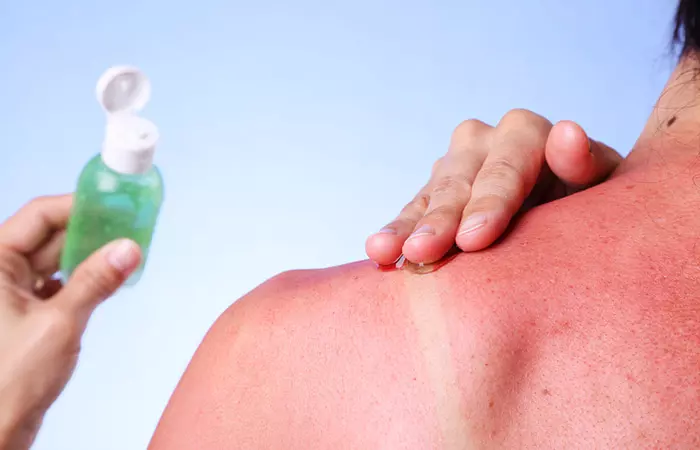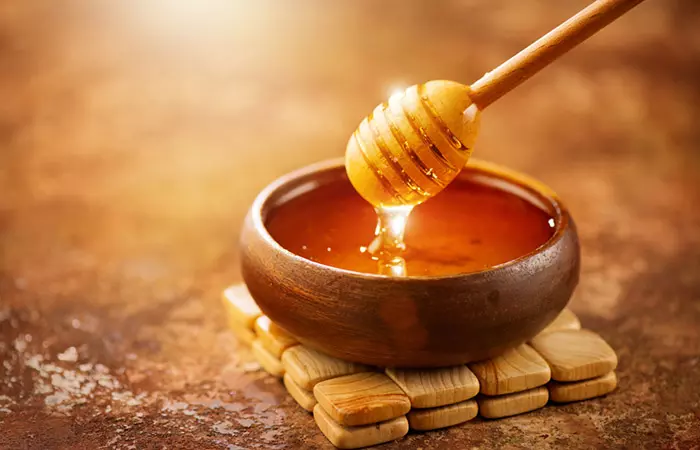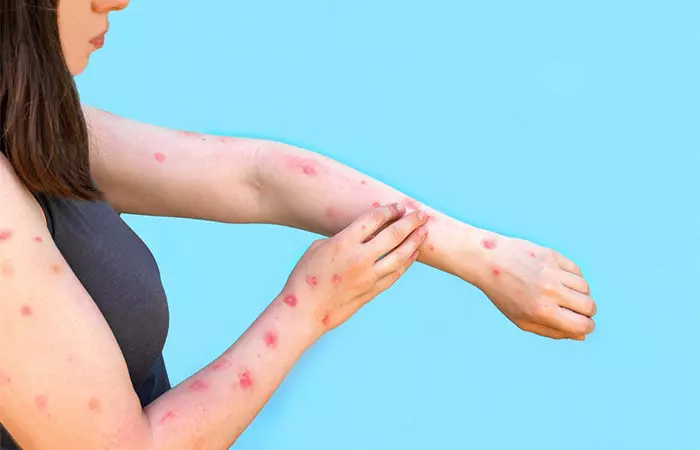Sunburn is one of the most common causes of peeling skin. As the weather warms up, it may be tempting to lay out in the sun. But your skin reacts to the sun’s UV rays and burns if you don’t use sunscreen or sunblock, which may lead to sunburn peeling. Sunburn is caused by a variety of factors, including the length of time spent in the sun, the time of day, the intensity of UV radiation, your skin type, and the use of any topical or internal treatment. Sunburn not only causes skin peeling and irritation but also increases the risk of skin cancer. So what can be done to prevent it? Is there any way to get rid of it? We have answered everything in this article. Keep reading!
What Is Sunburn Skin Peeling?
The sun damages the skin cells in the epidermis when your skin is overexposed to the harmful UV rays. The immune system in your body that is trying to protect you from harm gets overwhelmed, resulting in the damaged skin peeling off (1).
Wondering how long your skin will peel after a sunburn? Keep reading to find out.
How Long Does It Take For Your Skin To Peel After Sunburn?
Thankfully, sunburn skin peeling is a type of short-term skin damage (1). Your skin can start peeling anywhere from three days to a week following a sunburn. In general, the peeling stops after the skin has fully recovered. The entire procedure could take up to two weeks.
James Stewart, an Evangelical blogger, shares his story of experiencing severe skin peeling from sunburn: “I not only had the world’s hottest and worst sunburn ever, but I also experienced the world’s longest period of skin peeling that anyone has ever gone through after being sunburned. I was literally peeling for months after that (i).”
Once the damage has been done, there is no way to completely prevent peeling. You can, however, aid in the maintenance and healing of the healthy skin underneath. How? Let’s have a look at the next section to find out!
How To Get Rid Of Sunburn Peeling Skin
1. Cold Compress, Cold Showers, And Cool Baths
Using a cold compress or taking a cool shower/bath will not guarantee that the peeling will subside. However, if your sunburn is especially hot, inflamed, and unpleasant, the cool temperatures may provide temporary relief.
You can make a cold compress at home by filling a thick cloth bag with ice cubes or wrapping ice cubes in a washcloth. Never apply ice directly to sunburned skin because the extreme cold may cause further harm to the skin, worsening peeling and delaying the healing process.
 Quick Tip
Quick Tip2. Aloe Vera Gel
Image: Shutterstock
Aloe vera gel applied topically calms and hydrates sunburned skin while also reducing inflammation (2). These combined properties help to speed up the healing process of sunburn and shorten the skin peeling time.
Apply the gel directly to your skin from aloe vera leaves or use a natural over-the-counter (OTC) aloe vera gel product. Avoid any store-bought aloe vera gel that contains chemical preservatives as it might aggravate irritation.
3. Oatmeal Bath
Colloidal oatmeal has anti-inflammatory properties (3). Therefore, it can relieve the dryness and irritation caused by sunburn. It also aids the skin’s ability to retain moisture, which helps in the process of healing.
Colloidal oatmeal is not the same as breakfast oatmeal. Nevertheless, whole oats can be used to make colloidal oatmeal. Put some uncooked whole oats in a food processor or blender and grind them to a fine powder. Pour 2-3 cups of this powder into a lukewarm or cool bath and soak in it for 10-15 minutes.
4. Wear Loose-Fitting Clothes
Image: IStock
Sunburn and tight clothing make for an uncomfortable combination. Instead, wear loose, soft clothing to let your skin breathe and reduce the possibility of friction and further irritation.
5. Don’t Peel
One of the worst things you can do after a sunburn is peel off the excess skin. You risk causing an infection and exposing skin cells that are not ready to be exposed, which may result in scarring.
6. Take OTC Anti-Inflammatory Medication
Image: Shutterstock
Taking aspirin or ibuprofen, which are non-steroidal anti-inflammatory drugs, can help calm the skin and reduce some of the pain and swelling associated with sunburn. You can also apply over-the-counter hydrocortisone cream to the affected areas (1).
You can also crush a few aspirin or ibuprofen tablets and mix them with water to make a paste that you can gently apply to the affected area.
Avoid petroleum or oil-based lotions and moisturizers until your skin stops peeling completely.
7. Stay Hydrated
It’s time to start working from the inside out to cure peeling skin, in addition to external treatments. To be honest, nothing is more beneficial to your skin than a big glass of water. Adequate hydration is essential for healthy skin. Water becomes even more necessary when your skin is damaged, such as after a sunburn.
8. Other Home Remedies
Image: Shutterstock
There is not a lot of scientific evidence to support the use of a few home remedies for sunburn. However, they are safe to use unless you are sensitive or allergic to them. You can try:
- Applying menthol shaving cream to the skin.
- Adding baking soda to a cool bath.
- Applying honey to the affected area.
 Quick Tip
Quick TipWe have included some tips in the following section to help you prevent sunburn peeling. Keep scrolling to know more.
How To Prevent Sunburn Peeling?
- Apply sunscreen that contains SPF 30 or more every two hours.
- Stay out of the sun as much as possible.
- Keep as much skin covered as possible with long-sleeved clothes, hats, and light scarves.
- Wear sunglasses and a wide-brimmed hat when stepping out.
- Drink plenty of fluids to prevent dehydration.
- Avoid tanning beds at all costs.
Matthew W. Turcotte, a pop culture blogger, talks about using sunscreen of at least SPF 50 for recovering from terrible sunburns, in one of his blog posts. “Believe me, I know all about blistering sunburns. I acquired quite a few of them in my early childhood that were skin-peeling awfulness. After you experience a couple of them, you definitely don’t want to experience another one. And, I also have learned that applying it only once a day is not exactly the way you want to go unless you’re going to be outside for 30 minutes or an hour. Myself? I usually reapply sunscreen during breaks and my lunch hour (ii),” he says.
A 2018 online survey study was done on 3,106 participants to determine the contexts of sunburns in American adults. 50.7% of participants reported being outdoors for 1-3 hours, and 38.9% were outdoors for 3-6 hours. The most commonly stated context was swimming at 32.5%, while outdoor work was at 26.2% and vacationing was at 20.7%. Only 5.5% intended to get a tan. A total of 79.6% reported having used sun protection.
Sometimes, the skin peeling can get bad enough to require medical attention. Find out when you should consult a doctor in the next section.
When Should You See A Doctor?
Image: Shutterstock
Sunburn peeling is rarely a cause for concern and does not usually necessitate medical attention. However, you should get medical help if you notice any of the following symptoms:
- Swelling.
- Fluid oozing from the affected area
- Blisters that become inflamed or turn yellow.
- Fever, nausea, or chills.
You can also consult a dermatologist to learn about the best sunburn treatment options for your skin type and skin issues.
Sunburns do heal with time. This healing process happens in stages. Know more about them in the next section.
What Are The Stages Of Sunburn Healing?
- Initial Redness: The first stage involves tenderness and inflammation of the affected skin that is often accompanied by warmth and pain. It can occur within a few hours after sun exposure.
- Peeling And Blistering: Sunburn may also progress to blistering in some cases. These blisters can be filled with fluid and cause the affected skin to peel.
- Healing And Repair: The body begins to repair the damaged skin with time. The skin starts to regenerate. New, healthier skin cells replace the damaged ones.
- Itchiness And Flaking: After the initial healing, the sunburned area might become itchy as the damaged skin continues to flake off.
While the skin does return to its normal state with time, it still may remain sensitive to sunlight for a while.
Infographic: 7 Ways To Get Relief From Sunburn Skin Peeling
After getting sunburned, your sun-damaged skin may start peeling off, giving way to new skin. It’s important not to pick at the peeling skin and let it naturally shed. Avoid applying ice, pulling, or exfoliating your skin as this only causes more harm. Use the simple methods listed in the infographic below to relieve any discomfort and provide soothing benefits.
Illustration: StyleCraze Design Team
The Bottom Line
Skin peeling is a natural part of the healing process after sunburn. Simple home remedies – such as aloe vera and cold compress – can help reduce inflammation, itching, and redness, speed up healing, and reduce the degree and duration of peeling.
Sunburn peeling seldom requires medical treatment. But if you develop symptoms such as nausea, fever, or serious blistering, or if you notice signs of infection, consult a doctor immediately.
Frequently Asked Questions
Does peeling sunburn turn into a tan?
No, peeling sunburn may make your tan lighter and cause it to fade faster. However, avoid using tanning products while your skin is peeling to avoid uneven patches.
Is lotion or aloe better for sunburn?
Both lotion and aloe vera are good for sunburn. You can use a lotion or gel containing aloe to rescue inflammation and hydrate your skin (4). Avoid petroleum-based lotions until your skin is completely healed.
Is coconut oil good for sunburn?
Coconut oil may help hydrate the skin and prevent dryness from sunburn (5). However, it is advised that you apply coconut oil after your skin has healed.
Is Vicks Vaporub good for sunburn?
Anecdotal evidence suggests that Vicks Vaporub may provide relief from sunburn. However, there is no scientific evidence to prove this.




